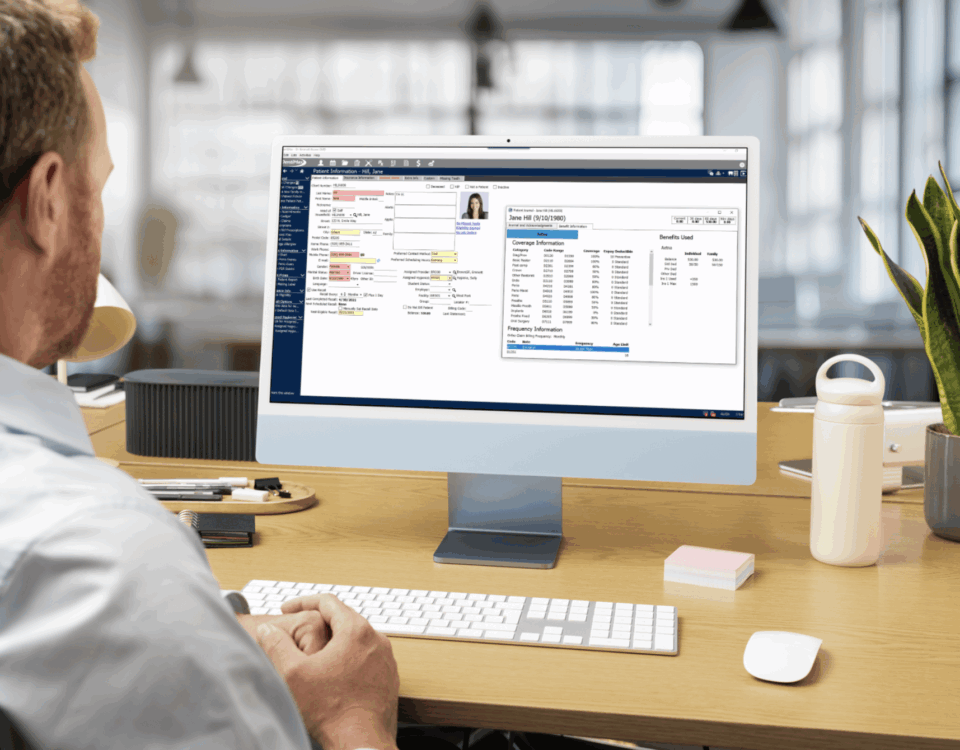What’s a dental office without a schedule? In the dental industry, we live and die by the clock. How long a patient has been waiting? Where can we fit in an emergency? How long do we need for this procedure/appointment? when is lunch time? Profitable scheduling is crucial to the success of a dental practice.
Tips for Profitable Scheduling
Template Your Schedule for Every Open Day
Templating your schedule is akin to having a balanced diet. NO ONE wants to do crown deliveries or multiple Try-in visits all day. Having a template for your day is the cornerstone of your schedule, and the first step in making sure you are as in control of the flow of your day as one can expect in a dental office.
If you have two hygienists, give them their own columns on the schedule to work from and make a plan to include time for Quandrant RPS, new patient time, kids appointments, and of course lunch time. Hygienists can help you significantly increase the volume of patients your office can see in a day, thereby leading to increased diagnosing.
Pay attention to appointments where you can double book patients. You may have a new patient appointment on the schedule for 90 minutes, but an FMX capture and paperwork review may occupy the first 30 minutes. Plan to multi-task by templating time to see an emergency patient or a hygiene exam while your assistant is getting the new patient ready for you. Make the most of the moments that you are not actively scheduled to be in a room performing a procedure, and you will surprise yourself at how much more you can produce in a week, month, or year.
When making your templates, don’t forget to gauge your mood throughout the workday. Some dentists for example, are much more energetic in the mornings versus after lunch, so if that’s you, plan to do your more difficult or longer procedures in the morning when your mind is clear and fully functioning! This will help you leverage the "good" hours of the day.
Honor Your Templating and Include Your Team
It doesn’t help to setup a plan for your day if your scheduling team doesn’t follow it. There is a lot of thought that goes into planning your ideal day, and for good reason! You can’t always be perfectly on point in your templating, but you should be able to reach the mark if your goals are reasonable and you’ve discussed them with your team. Having a consistent workflow will not only help you produce, but it will help smooth out the pace for your staff’s workday too.
Have meetings about what hours are hardest for everyone to stay motivated during the day. Is there a trend there? Talk openly about what people think they could do differently during those times to make it easier/smoother for everyone. For example, new patients sitting for a long time in the waiting room makes it hard on everyone, especially when you are trying to make a good first impression.
If you consistently run late for new patients, consider seeing new patients first thing in the morning and right after lunch – that way any carryover from previous appointments is either eliminated or dealt with by the new patient appointment time. This will allow your staff to seat the new patient in a timely manner and alleviate some stress from having to confront a patient who has been left waiting that doesn’t know how awesome your team is yet.
Get your team to agree if there is an open time for a crown, they can’t fill it with anything else until two days before with a procedure other than a crown (or bridge, or something else of equal value). Leaving these openings available as intended will help everyone focus on what your production goal is. This will help them "look for" the unscheduled patients .
Set a Production and Collection Revenue Goal for the Day/Week/Month
How much money do you need to make each month to cover accounts payable? Do you have enough to cover your personal expenses? How much money do you want to make a month to more quickly pay off student loan or equipment debt? What about having some extra income to enjoy life a bit more? A daily, weekly and monthly goal will not only help you focus on producing the work you will need in order to collect a certain amount, but it will also help you focus on treatment diagnosis.
For the doctors, having a profitable scheduling goal each month is important to making sure the bills get paid and the doors stay open. Have you ever heard, "if you fail to plan, you plan to fail"? If you do general dentistry, what’s the procedure that makes you the most profit? How many of those do you diagnose a day?
If you diagnose four crowns a day, you should be able to get at least two or three of those accepted by the patient, so template your schedule to do two crowns a day. diagnosing three bridges or implants a week, template a high production slot on your schedule so you can get those done! If you don’t plan your time for financial success, it makes it harder to achieve your goal.
Practical Goals
Keep in mind your goals need to be realistic. You cannot template for ten crowns per week if you only diagnose two per week. Consider how many times you have opted to do a filling on a tooth that really needed a crown. Not all patients will understand that the filling you offered them is just meant as a temporary solution to try and save them money.
In the end, the doctor ends up losing time, money, and some credibility for not doing the crown in the first place. On top of that, poor scheduling can irritate the patient having to come back for more work on the same tooth, or think you did an incomplete procedure the first time. If you know the tooth will need a crown, consider offering that option sooner rather than later.
Be Aware of your Openings and Where You Stand Toward Your Goals for the Month
Everyone in the office should know when your next opening is. Having a short morning meeting and reviewing those openings can really help rally the team to fill up the next soonest time. Your hygienist could be prepping the patient to come back tomorrow while you are looking at the x-rays by saying, "Doctor, I know we are pretty booked up, but do you think this is something we can work into our schedule in that time slot tomorrow to make sure to take care of Mrs. Smith quickly?".
When you say yes, (because you know there is still a large opening for tomorrow), you look like the hero who is taking good care of getting your patient’s issue resolved quickly, and naturally creating some urgency in getting the tooth fixed. The tooth will not get better on its own, so it’s best to fix it sooner, rather than later. Why not convey that to the patient? Your team will back you up if everyone knows what slots need to get filled.
Make Sure Every Patient Leaves Your Office With a "Next Appointment"
This is one of the easiest and most effective ways to keep your schedule full. It is easier to remind patients about an appointment they have coming up, then to track them down and convince them to schedule a new appointment! People are busy. They don’t usually know if they will be free that date six months from now, but if you set the expectation that you will send a postcard (or text/email/smoke signals) in advance so they can change that day if needed, suddenly you are doing them a favor.
Do not give them an opportunity to go find a "more convenient" dentist. Keep the patients you have coming back for something, anything, at all times!
Use your ASAP/Short Call List and PUT Everyone On It!
Short call, ASAP, cancellation lists, they’re all the same and designed to help you fill your schedule on short notice. It’s not a matter of IF someone will cancel, it’s a matter of when, and WHEN it happens, you will want to act! You can never earn the time or money back on an opening that did not get filled. Tell all your patients (hygiene, fillings, crowns/high production appointments) that you will be calling them to get them in sooner if something happens to open up for them.
The worst they can do is say, "no, I won’t be available before that date we scheduled", and that’s ok. Ask them what their preferred scheduling hours are if something does become available. Set the expectation that they may hear from you, and that you will try to make it as convenient as possible, and they will be more likely to respond if they actually do get a call for a short notice appointment. The mental preparation you’ve just set up will reduce the chances that they say "no" exponentially. Don’t forget to use your will call list and review that weekly for people who want to reschedule as well. These are usually folks who already agreed to the appointment and scheduled but couldn’t make it for whatever reason. This process primes them to come back in on short notice.
Have a Confirmation Routine and Set the Expectation
Set an expectation for your patients about how your team is going to help them make it back to your office. Find out what the patient’s preferred contact method is and the best time to call them, and make it happen. Take the stress off them for having to remember an appointment so far out.
"Don’t worry Mrs. Smith, we will get in touch with you two weeks in advance before your appointment, so you have enough time to plan, or change that appointment if needed. Would you prefer a call, email, text or postcard for us to remind you? We will be happy to change that appointment time when we reach you if you find it doesn’t work for you anymore. Also, here is our phone number you can save and text as well if you see it’s not going to work before we reach out to you".Do your confirming when you say you will. Also, always confirm in the morning so you get any cancellations out of the way early and have the most time in the day possible to fill those unexpected slots.
Don’t Forget about Family Members
When one member of the family comes in, take a minute to look at the rest of the family tree. Are they scheduled for an appointment (because remember, everyone should have a next appointment)? If not, when scheduling the patient’s next visit, get the family members taken care of too! It’s so easy to miss because they are not standing in front of you, but look at the account/route slip, check the family recall screen, and make sure everyone has a next visit. If not, have notes in the software as to why.
Use Your Software to Track Recall and Help You with Confirmations
There is NO REASON these days for your office not to have a dental software system that will help you track when someone is overdue for recall and will help you confirm patients. Your front desk staff has a lot to do (more than you probably know), most importantly, keeping your patients happy, paying, and coming back. Give them a little help by having software to track recall at a minimum.
Once you have software doing this, make sure you are using the automated reminder functions (emails, texts, phone calls, post cards, letters, etc.). Even go as far as to have an online scheduling option for your patients. We’ve found some people (like me) remember they need a dental appointment at midnight. Having an option to schedule online will allow these people to schedule when they think of it, and then they won’t have to remember to call your office during business hours! Make it easy for them to get on your schedule and communicate with you.
DentiMax offers all the tools I’ve discussed here, and many more! We have staff with the dental experience and know-how to help you get the most out of your profitable scheduling. Please don’t hesitate to reach out and let us know what we can do to help you and your practice grow!







